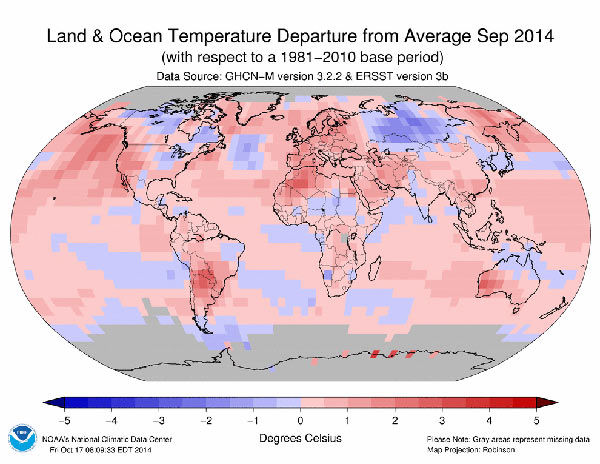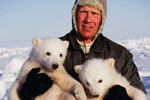
Male, the capital of the Maldives. One of the world’s lowest lying island nations, the Maldives is on the front line of rising seas caused by global warming. Photo by: Shahee Ilyas/Creative Commons 3.0.
With the news that September was the warmest on record globally, 2014 takes one step closer to being the warmest year since record-keeping began in the late 19th Century. Last week, NOAA announced that September was 0.72 degrees Celsius (1.30 degrees Fahrenheit) above the 20th Century average, not only making it the hottest yet, but further pushing 2014 past the current ceiling.
“If 2014 maintains this temperature departure from average for the remainder of the year, it will be the warmest calendar year on record,” said NOAA in a statement.
According to NOAA, 2010 was the warmest year on record, 2005 comes in second, and 1998 third. But this year could top all of them. In fact, September was not the only-record breaking month this year. According to NOAA, May, June, and August were also top record months.
Current warming is driven by continually-rising greenhouse gas emissions, the bulk of them coming from burning fossil fuels, such as coal, oil, and gas. Deforestation and industrialized agricultural are also playing a smaller, but still, important role in driving global temperature upwards.
The fact that 2014 may be the warmest year on record is especially surprising given that it is—not yet at least—an El Nino year. El Nino conditions, driven by warm sea surface temperatures in the Pacific, are important because they push global temperatures up. In fact, most of the warmest years on record are El Nino years.
But to date 2014 hasn’t seen its long-anticipated El Nino. Sea surface temperatures have been high in the region for months, but just always below required conditions.

September 2014 as compared with average Septembers from 1981-2010. Photo by: NOAA.
“Although El Niño conditions were not officially present across the central and eastern equatorial Pacific Ocean during September, NOAA’s Climate Prediction Center favors El Niño to begin in the next one to two months and last into the Northern Hemisphere spring 2015,” reads the NOAA statement. This means that 2015 would also likely be among the warmest years on record.
NOAA has found that if the next three months (October-December) are equal to the averages of the warmest ten years on record then 2014 will be a record-breaker. If, however, the next three months is equal to the average of the 21st Century to date then 2014 will tie with 2010 as the warmest.
Still, NOAA climate scientist Jessica Blunden, told the Associated Press that “it’s pretty likely” 2014 will be the hottest year yet.
However this year turns out, the world continues to heat up. Blunden said that NOAA’s data shows clear global warming, and to those that erroneously claim the planet’s temperature hasn’t risen since 1996, she says, “no one’s told the globe that.”
Related articles
Artists, musicians, writers protest government plans for massive coal plant in the Sundarbans
(10/28/2014) Over the weekend, Bangladeshi artists performed plays, sang songs, and recited poetry all in a bid to protect the Sundarbans—the world’s biggest mangrove forest—from the threat of a massive coal plant. Construction is already under way on the hugely controversial Rampal coal plant, a 1,320 megawatt plant set just 14 kilometers from the edge of the Sundarbans.
Coal, climate and orangutans – Indonesia’s quandary

(10/21/2014) What do the climate and orangutans have in common? They are both threatened by coal – the first by burning it, and the second by mining it. At the recent United Nations Climate Summit in New York, world leaders and multinational corporations pledged a variety of actions to reduce greenhouse gas emissions and deforestation to avert a looming disaster caused by global warming.
Could California be facing a mega-drought?

(10/13/2014) Scientists and politicians, everyone agrees: California is in deep trouble. As the state enters its fourth year of drought and the soil has never been drier. Some look at the sky with hope that El Niño will bring much needed rain. But most are starting to wonder if this is just the beginning. Are we entering a mega-drought that could last for more than a decade?
Forest fragmentation’s carbon bomb: 736 million tonnes C02 annually
(10/09/2014) Scientists have long known that forest fragments are not the same ecologically as intact forest landscapes. When forests are slashed into fragments, winds dry out the edges leading to dying trees and rising temperatures. Biodiversity often drops, while local extinctions rise and big animals vanish. Now, a new study finds another worrisome impact of forest fragmentation: carbon emissions.
The only solution for polar bears: ‘stop the rise in CO2 and other greenhouse gases’

(10/08/2014) Steven Amstrup, Chief Scientist for Polar Bears International, has worked diligently on polar bears for over 30 years. He radio-collared some of the first bears and discovered that annual activity areas for 75 tracked females averaged at a stunning 149,000 square kilometers. His recent work highlighted the cost of global warming to these incredible animals and the sea ice they so closely depend on.
Throng of 35,000 walruses is largest ever recorded on land, sign of warming arctic

(10/01/2014) A mass of thousands of walruses were spotted hauled up on land in northwest Alaska during NOAA aerial surveys earlier this week. An estimated 35,000 occupied a single beach – a record number illustrating a trend in an unnatural behavior scientists say is due to global warming.